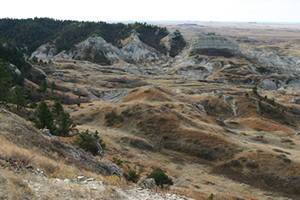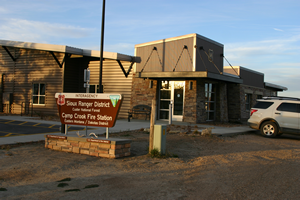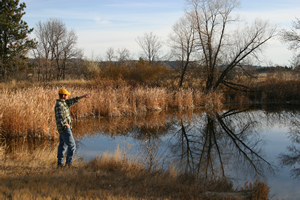Sioux Ranger District

Encompassing eight separate land units in southeast Montana and northwest South Dakota, the Sioux Ranger District rises with mesas of ponderosa pine and stretches out into the rolling grasslands.
The district office is located in Camp Crook, SD and covers a total of 163,000 acres spread across a distance of 100 miles.
The Sioux Ranger District is rich in archeological and paleontological resources and also includes two National Landmarks: Capitol Rock and The Castles. Each are massive sandstone outcroppings, remnants of volcanic ash.

The Sioux Ranger District offers excellent antelope, mule deer, white-tail deer and turkey hunting. Many recreationalists also enjoy hiking, horseback riding, cross country skiing, snowmobiling, mountain biking, fishing, camping and bird watching.
Tidbit Trivia: Did you know?
One of the largest populations of Merlins (a small falcon, in the raptor family) known in North America occurs on the district.
The following campgroungs and picnic facilities are available:
In Montana: Lantis Springs and Wickham Gulch, Long Pines Unit, Ekalaka Park and McNab Pond in the Ekalaka Hills Unit
In South Dakota: Reva Gap, Slim Buttes Unit and Picnic Springs, North Cave Hills Unit
Opportunities for dispersed recreational activities are numerous throughout the district. There are no designated hiking trails, but most of the ridges are open and provide spectacular panoramic views.
In addition there are two fishing ponds on the district, Rabbit Creek in the Slim Buttes and McNab Pond in the Ekalaka Hills, stocked with crappie, bass and rainbow trout. All recreational sites are typically open from mid-May - end of November.
To learn more about recreational facilities and local conditions, visit the recreational portion of this website or call the Sioux Ranger District.
Sioux Ranger District Front Office: 605-797-4432
Know before you go
Visit the Custer National Forest's Minerals and Geology page to learn about naturally occuring minerals on this district. Understand acceptable exposure levels.
Uranium Mine Clean-up
Erionite Health Concerns
Erionite is a naturally occurring mineral that belongs to a group of silicate minerals called zeolites. It is usually found in volcanic ash that has been altered by weathering and ground water. Like naturally occurring asbestos, deposits are present in many Western states. Read More...
Additional Information
North Dakota Department of Health - Erionite
http://www.cdc.gov/niosh/programs/crcd/outcomes.html
Alerts & Warnings
- West Boulder Campground water outage
- Hyalite Target Shooting Closure
- Beartooth Ranger District Road and Trail Closures 01-11-82-23-05
- East Rosebud Road 2177 and East Rosebud Trail 15_Restrictions 01-11-82-23-03
- 01-11-04-23-03 Yellowstone Ranger District Camping Area Closure
- Woody Creek Road Closure
- Road #3089, Closure, Sioux Ranger District
- McConnell Fishing Access and Beattie Gulch Area Shooting Closures
- Hyalite Drainage Proposed Permanent Recreational Target Shooting Restriction

